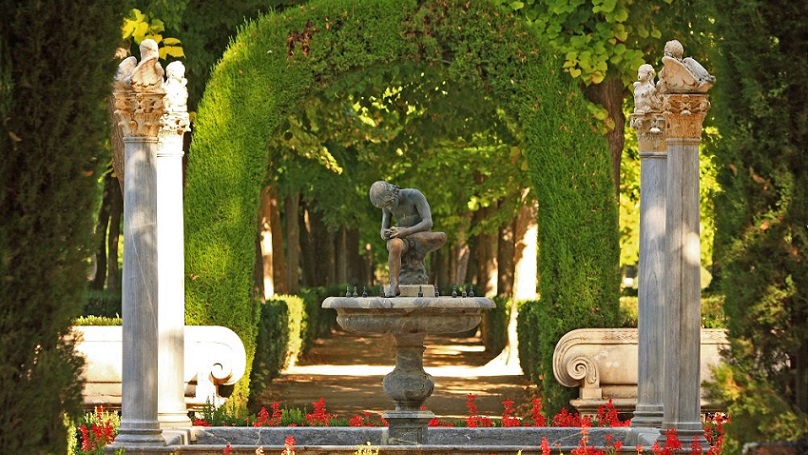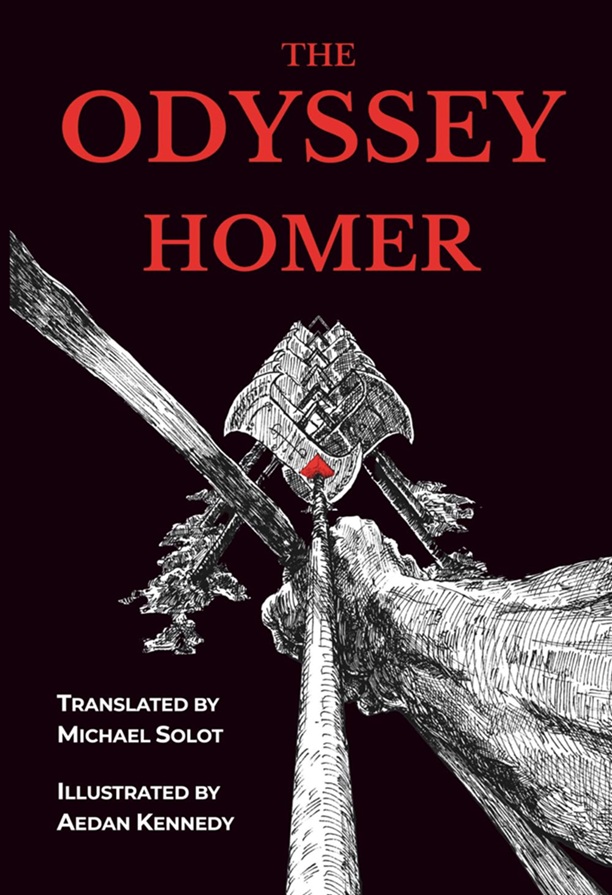Aranjuez (ar-ON-wess) has been one of the estates of the royal family of Spain. It is near Madrid and the Tajo (TAW-hoe) River flows through it. The Fountain of the Thorn includes, as its centerpiece, a bronze statue of a young boy removing a thorn from his foot. This is surrounded by pillars topped by four harpies. The below poem on the fountain is a translation from the original Spanish by Martin Hill Ortiz.
Where, by works of art compressed, the Tajo River
flows with depths that ease the progress of its passage.
It advances onward, tamed but arrogant,
being drawn along by forceful, haughty currents.
There exists a verdant forest in its center
where both elegance and majesty reside:
celebrated hidden haven of the Graces,
the exquisite dwelling place of mythic nymphs.
Here, expansive waterways and broad cascades
amplify the luscious pleasures of the site:
roaring and performing random pirouettes,
an enrapturement to please the ear and eye.
Down a thousand paths the poplars, evergreen,
cross their branches. Their cathedral pomp aspires
first to blot and then replace the dome of air;
In what radiance remains, the stars join in.
Sundry fountains decorate the chamfered corners
of this pleasant, hanging garden. They enrich
with a scattering of crystal drops the soil
which revivifies the flowery retreat.
First, above all else, the sculptures elevate,
laud, the wellspring named the Fountain of the Thorn,
masterwork created to commemorate
Praxitéles, Lisipo, and Phidias:
In an area encompassed by four arbors,
each of which is topped at midpoint by a cornice,
these display in their design artistry and
craftsmanship: sublime and simple, unpretentious.
At the verdant center of this royal square,
where the Fountain of the Thorn presents its pool,
can be seen a statue. In its form competes
artist and material, both obstinate.
It depicts a boy whose foot has been afflicted
by a piercing thistle thorn. The pain demands
that he plucks the barb out carefully. It shows
by his stress the soreness of the wound, and yet. . .
the dispassion of the statue controverts
the ordeal presented on his anguished face
which, if it were not the golden hue of bronze,
this creation would excite the human heart.
The appealing angles that surround this fountain
are defined by pillars; they have cornices
at their peaks supporting ornamental caps
that present the image of the faithless harpies,
who from out their mouths and flowing nipples shoot,
in incessant jets of crystal, aqua pura,
streams which mingle after brief but sportive flights,
the conclusion to the trek of melted snow.
Scattered here and there around this charming site
lie some benches which have varied symmetry,
that provide a moment’s rest to weary mortals,
an occasion to relax and savor beauty.
On the trunks of robust trees, the ancient ivy
gorges to increase the vigor of its verdure
which the fevered blaze of Phoebe soon curtails,
thereby rendering the day subdued and peaceful.
Perched atop the branches dulcet little birds
with their cheerful twittering apprise you that
you have failed to heed the summons of their songs,
witcheries designed to steal the sense of sight.
So, we find that nature, acting as creator,
ruling from its lofty throne, has here united
art to its endeavors, featuring its treasures,
and provided lush delights which never cease.
I’ve admired its splendor once, a thousand times,
and I sensed a gratitude within my soul
filling me each stay in this serene enclosure,
feeling overjoyed as I observed its wonders;
In their arrogance the crowds of mortal beings
with a crazy self-importance tromped the grounds,
so Apollo stirred in me this dulcet meter,
chanting verses to the Fountain of the Thorn.
Original Spanish:
Descripción de la fuente de la Espina en el Real Sitio de Aranjuez: romance endecasílabo
Donde oprimido el Tajo por el arte
en hondo cauce el curso facilita,
mudando en mansedumbre la soberbia,
con que arrastraba su corriente altiva:
yace un frondoso bosque, cuyo centro
la majestad, y la hermosura habitan;
asilo celebrado de las gracias,
morada deliciosa de las ninfas.
Anchurosos canales y cascadas
aumentan de este sitio las delicias,
siendo su estruendo y vagaroso giro
encanto del oído y de la vista.
En sendas mil los chopos siempre verdes
cruzan sus ramos, y su pompa aspira
a eclipsar de la bóveda del aire
la luz quede los astros participa.
Varias fuentes adornan las ochavas
de este ameno pensil, y fertilizan
con desperdicios de cristal el suelo,
donde renace la estación florida:
Pero entre todas la escultura eleva
el nombre de la fuente de la Espina,
obra que diera honor a la memoria
de Praxitéles, de Lisipo y Phidias:
de cuatro cenadores rodeada,
que en medios puntos cubren sus cornisas,
muestra la arquitectura las bellezas
más sublimes del arte y más sencillas.
En el centro frondoso de este cuadro
la fuente muestra su anchurosa pila,
presentando la estatua, en que compiten
la materia y artífice a porfía.
De un joven es, que de su pie doliente
la punta de un abrojo solicita
arrancar cuidadoso, demostrando
con su actitud el daño de la herida:
desmiente lo insensible de la estatua
la aflicción, que en su rostro se nos pinta;
y a no ser su color dorado bronce,
la humana compasión excitaría.
Los ángulos hermosos de esta fuente
en columnas se apoyan; sus cornisas
sostienen al remate por adorno
el rostro engañador de las harpías,
por cuya boca y pecho se desatan
los raudales del agua cristalina,
que tejiendo cruceros agradables
quedan al fin en nieve derretida.
En torno de este sitio deleitoso
asientos hay con varia simetría,
que brindan el descanso a los mortales,
el tiempo que disfrutan sus delicias.
Robustos troncos, que la antigua yedra
cubre para aumentar su lozanía,
los ardores de Febo disminuyen,
y hacen templado y apacible el día:
en sus ramos los dulces pajarillos
con alegres gorjeos solicitan
se olvide para oírlos el encanto,
que arrebata el sentido de la vista.
En fin, naturaleza creadora,
como en su trono, en este sitio unida
del arte a los esfuerzos, sus tesoros
y sus deleites sin cesar prodiga.
Yo admiré su esplendor: una y mil veces
sentí de gratitud el alma mía
llenarse en este plácido recinto,
gozosa de observar sus maravillas;
y en tanto que engreídos los mortales
en loca vanidad su centro pisan,
Apolo me inspiraba dulce metro,
para cantar la fuente de la Espina.
Martin Hill Ortiz is a researcher and professor at the Ponce University of Health Sciences in Ponce, PR where he lives with his wife and son. He has three novels published by small presses: A Predatory Mind (Loose Leaves Publishing, 2013), Never Kill A Friend, (Ransom Note Press, 2015), and A Predator’s Game (Rook’s Page, 2016).















A fine translation of a fine poem…but is the Spanish text really the original, or has it been modernized?
Martin,
While I don’t speak Spanish, I thought your translation was beautiful and gripping! Thanks much.
Leo
I believe the Boy with Thorn is a copy of the statue in the Capitoline Museums in Rome. He is in a lovelier setting at Aranjuez.
The meter here seems to be trochaic hexameter, which is a rarity indeed. The lines with masculine endings are catalectic, which is necessary if one is to have masculine endings at all.